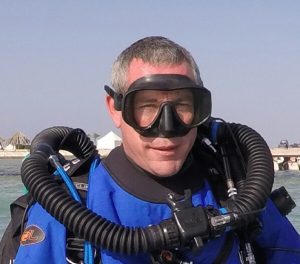Mark had his first experience of diving at the age of 10 when he did a try-dive in a local pool. He was hooked from that point onwards. He learnt to dive in 1987 and has been diving ever since. He has dived in the Red Sea, Costa Rica, Sri Lanka, California, Gulf of Mexico, Middle East, Truk Lagoon, Caribbean and the Mediterranean. However he is most at home in the waters around the UK where there is some of the best wreck diving in the world.
Mark became an instructor in 1994 and has been actively instructing since then. In 2002 Mark set up Dive-Tech, a dedicated technical diving facility, with the intention of providing the highest quality technical diving training. He has been a full time diving instructor since then. Dive-Tech provides technical training at all levels up to and including CCR Advanced Mixed Gas Instructor Trainer. It also provides consultancy services to other diving organisations.
Mark is a TDI/SDI Instructor Trainer and a member of TDI/SDI’s Global Training Advisor Panel. He also represents TDI/SDI on a number of international standards groups. He is a regular contributor to a number of diving magazines and a regular speaker at Diving conferences around the world. In 2008 Mark published Deco for Divers, a widely acclaimed overview of the theory and physiology of decompression. This has quickly become the standard text on the subject and is recommended reading by a number of the technical diving agencies. In 2010 Deco for Divers was awarded “Publication of the Conference” at the EuroTEK.10 technical diving conference and in 2014 it won the Media Award at TekDive USA. In 2019 Mark followed this up with a new book Technical Diving – An Introduction.
How and why do you use checklists?
Checklists are an essential part of my rebreather safety routine. No one intentionally jumps in the water with their oxygen turned off and yet it happens with tragic regularity. This occurs because the diver completely believed that everything was OK and didn’t spot that they made a mistake. I know that I, just like everyone else, sometimes make mistakes and so I use a checklist to try and mitigate that risk by giving myself an opportunity to spot the mistake I have missed.
There are different types of checklists and each plays a different part in my preparation.
The first type is a build list rather than a checklist. This is the list of steps required to assemble the rebreather. I teach all new rebreather divers to follow this build list initially. However, with practice, this build list can become internalised, and does not need to be a physical checklist. In addition this list will sometimes change depending on the situation. I may opr may not need to refill the scrubber between dives. I may or may not need to refill cylinders between dives. The rebreather may be 90% assembled between dives so there is no need to start from step one in this case.
The second type is a functionality checklist. Once the rebreather is assembled does it now work correctly? It doesn’t matter what the starting point of the assembly was, whether it was 0% assembled or 90% assembled, this step is still the same. I am checking the key points of functionality. This functionality checklist is intended to find any issues in the assembly and so is the check list t prove that the assembly build list was completed correctly.
The last, and to my mind the most important checklist, is the pre-dive checklist. This is done immediately before I jump in the water and ensures that the rebreather is working and ready to dive. This is critical because even if the unit was completely working at step 2 there are all sorts of things that can go wrong between that functionality check and jumping in the water. It is not unusual to perform a full functionality check and then turn off the handset and cylinders for final transport to the dive site or during a boat journey. In this case, even though the unit was working perfectly, we have now changed that state. It would be feasible to forget to turn on the cylinders before jumping in unless a final check is made.
This final check does not take long;
– Are the cylinders on? – reach back and physically confirm this
– Do the Manual Add Valves work? – inject gas on each MAV and check that the pressure stays constant
– Are the primary and secondary electronics visible, configured correctly and working?
– Is the PPO2 breathable and the unit is maintaining the setpoint?
– Is the bailout on and working?
– Is my Wing/drysuit inflation working
These checks only take a couple of minutes and I tend to run through them while doing a final prebreathe. By running through these checks I know that my oxygen and diluent are turned on, the rebreather is working and maintaining the ppO2, I have accessible bailout and a method of achieving positive buoyancy. In other words I have confirmed that none of the causes of the majority of rebreather accidents are present on this dive.

